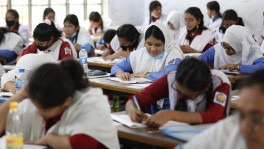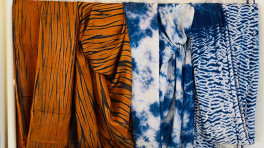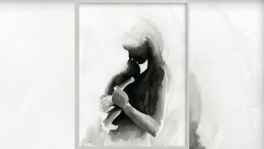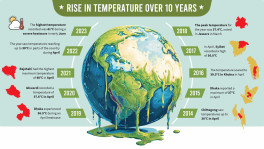RMG growth is backed by volume, not price. What can turn the tide?
Managing Director of Shasha Denims Ltd and former president of Dhaka Chamber of Commerce and Industry (DCCI), Shams Mahmud, shares his views with The Business Standard on strengthening RMG owners’ bargaining capacity and convincing buyers to pay a better price
Despite the Covid-19 pandemic, the country's ready-made garment (RMG) sector has been experiencing robust growth and continued to deliver outcomes far exceeding expectations.
According to the latest data, during July-December period of fiscal year 2021-2022, apparel export increased by 28 percent, compared to the same period of fiscal year 2020-21.
Around the first quarter of fiscal year 2021-22, the RMG sector accounted for more than 80 percent of our total export earnings with $19.9 billion.
Although the RMG sector continues to be one of the biggest strengths of our economy with its high export earnings, experts believe its growth is driven more by volume and not price.
Looking at our export performance in the US and EU markets (together they account for more than 70 percent of our global RMG exports), it was further understood that the growth was indeed backed by volume and not so much by price.

For example, in the US market, during the July-November period of fiscal year 2021-22, export volume (in dozens) increased by 26 percent and the apparels price (per dozen) increased by only 2.9 percent compared to the same time period in fiscal year 2020-2021.
Similarly, in the EU market, during the July-November period of fiscal year 2021-22, the increase in volume (in kgs) was 15.3 percent whereas the increase in price (per kg) was only 2.4 percent.
While the export growth in RMG is appreciable, according to garment makers, international buyers are still unwilling to pay higher prices.
At the launching programme of securing green transition of the textile and readymade garments sector in Bangladesh recently held in Dhaka, garment makers mentioned that even after spending more for establishing green factories, they were not getting the premium prices from retailers.
Managing Director of Shasha Denims Ltd and former president of Dhaka Chamber of Commerce and Industry (DCCI), Shams Mahmud, shared his views with The Business Standard on strengthening RMG owners' bargaining capacity and convincing buyers to pay a better price.
The RMG sector has been performing consistently well with high export earnings. What would be your take on the recent growth?
We have come a long way over the last three decades and Bangladesh's growth story is now well known all across the world. The RMG industry has played a pivotal role in this regard.
All stakeholders including the government, entrepreneurs, workers and brands have all worked side by side to bring this industry to the stage we are at now.
We have invested heavily on new green factories along with all member factories of BGMEA, BKMEA, BTMA where workplace safety has been ensured rigorously along with implementation of laws protecting workers rights.

All these have made Bangladesh into the ideal destination for different brands. This, besides the fact that during the early days of Covid-19 pandemic when there was a supply chain shock across the apparel sector in the world, Bangladesh was less affected than other countries.
That was due to the strong backward linkage with industries comprising fabrics and accessories, which have also come of age, along with the RMG industry.
The ability to withstand these shocks and deliver goods on time has earned Bangladesh the brands' confidence. This has placed Bangladesh as a top sourcing destination by a majority of the buyers, as witnessed in a recent survey by Mckinsey.
The recent unrest in Myanmar and Ethiopia has also shifted more orders to Bangladesh.
According to garment makers, international buyers are reluctant to pay higher prices. How much of this do you agree with?
Traditionally, we work with samples provided by the buyers. As such, it usually means that they are shifting continuous orders from an existing supplier.
Buyers will try to lower their existing purchase price in this situation to get a better deal. Also, in recent years, orders placed by buyers are becoming smaller in quantity as they want to keep less inventory, change product styles swiftly and keep shorter shelf cycles.
The RMG industry in Bangladesh is more suited to bigger quantity orders. So, when faced with taking orders at lower cost than having sewing machines sitting idle, we take the orders at lower prices.

In recent years, we have seen factories are now adapting quickly to working with smaller quantity orders than they used to handle previously; ergo, becoming more versatile and responsive to the shifting consumer demands.
With that and more orders coming in towards Bangladesh, the issue of getting lower prices will, in the near future, not be there anymore, I personally believe. We are going through a transitionary period.
What would you suggest for garment owners to do in order to strengthen their bargaining capacity?
It would be difficult to win over buyers with sample copies of products. So investing in Research and Development is extremely important and many garment companies are now making their own design solutions.
Any buyer will pay for a one-stop solution, which has been developed by keeping in mind the latest fashion trends.
Additionally, communication with buyers is key for success; it is important to develop a partnership where both parties are aware that growth of one would lead to the growth of another and vice-versa.
Buyers are also a part of our growth story. We need to incorporate our best practices with the brand's image and story. For example, we are working closely with brands who are positioning themselves with the concept of circularity.
We have developed fabric from recycled ocean plastic and discarded clothes. Brands will pay fair prices for the right products which go well with their image and philosophy. Such understanding from the manufacturer's end will provide the strength at the time of talking about fair prices.
So, garment owners need to have clear communication with buyers? Anything else they need to be aware of?
Communication is key. In case of any problem, you should try to let the buyer know beforehand. Say, you informed the buyer at the beginning of the season that the price of raw materials might go up. That way, s/he remains aware of the situation and does not mind paying for an upcharge.

Being updated is also important; one ought to know the current trends and concepts around the world, such as sustainability and circular economy. Understanding consumer mentality and demand also plays a big role.
Why do you think adopting green technology in RMG factories has not helped in increasing prices?
Latest technology does not ensure a higher price, your products will have to speak for themselves. We have to innovate, make use of green technology and come up with new products.
Also, just investing in new technology will not warrant higher prices. We have to create and share a story, where all the strands of a yarn come together.
We have to highlight the work environment, social compliance, innovation and looking at the brands not as a buyer but a partner. Everything has to be showcased in a cohesive manner.
Also, we need to highlight the energy savings when showcasing a product. Instead of just showing a pair of jeans, we need to tell the buyer that this product has been manufactured using a sustainable process where enough water has been saved to make 10 cups of coffee.
What role should the government play in strengthening RMG owners' bargaining capacity?
The government has an indirect involvement in this regard. The success story till now has been largely due to the continuous support extended to this sector through policies.
In a recent report by UNCTAD, it was mentioned that proper policy support to the RMG sector needs to be given for smooth transition from LDC to MDC.
The Government needs to formulate a policy which encourages Research and Development, keeping the future consumer demand in mind. Circular economy will play a big role in the RMG industry. Proper policies need to be in place to facilitate this.
Also highlighting the phenomenal advancement made by the industry along with best practices and green initiatives all need to be highlighted in roadshows abroad.
With the right policy support, the industry will be able to command a position to attract fair prices for all products, which are 'Made in Bangladesh' with pride.
 Keep updated, follow The Business Standard's Google news channel
Keep updated, follow The Business Standard's Google news channel
















